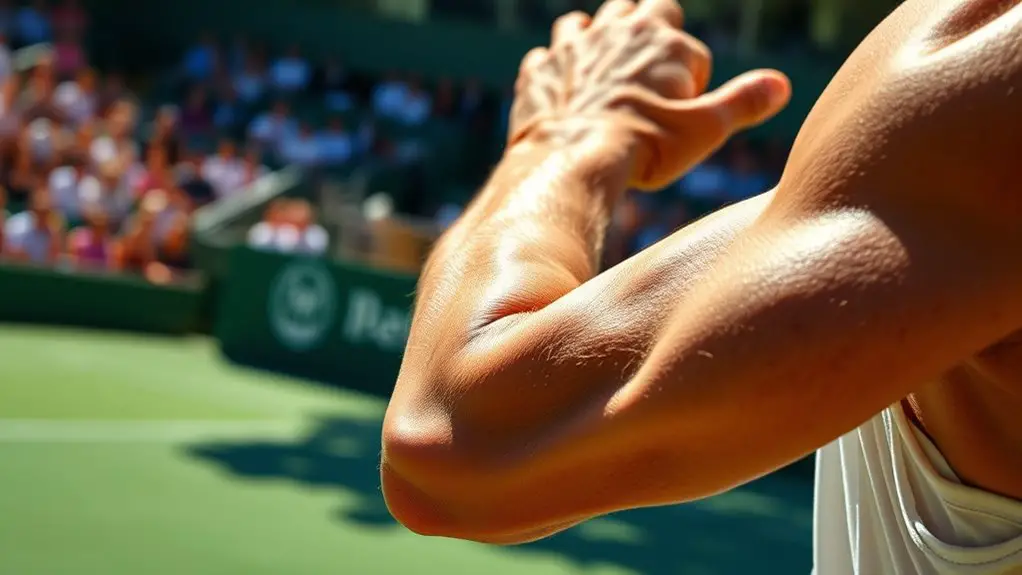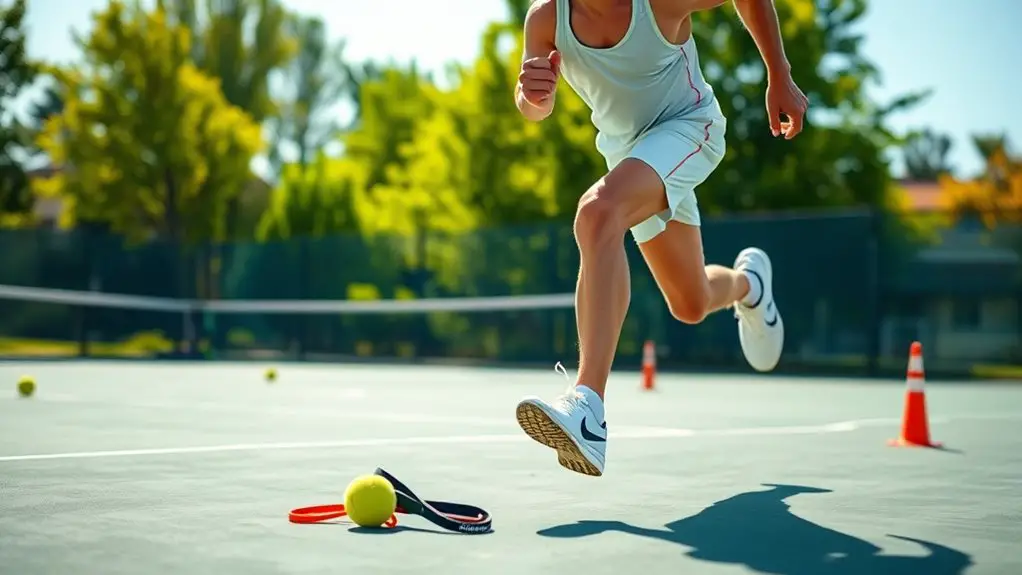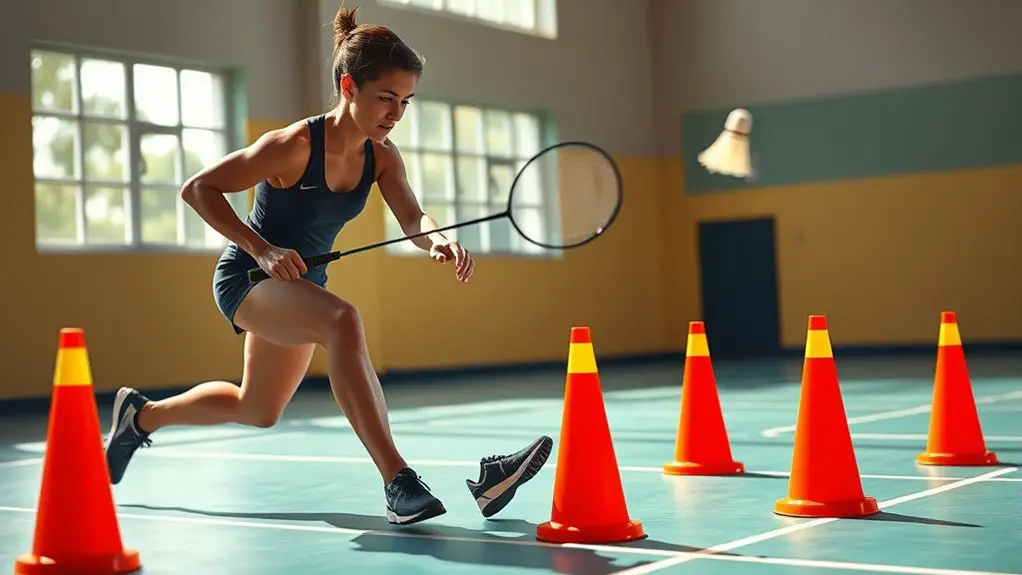Forearm strength is essential for your tennis power, as it greatly affects your shot speed and precision. Strong forearms enhance muscle coordination, allowing for faster racquet acceleration and better grip control. This stability reduces the risk of injuries, ensuring you can maintain performance throughout your matches. By focusing on forearm training, you'll improve your overall game, leading to more effective serves and fewer unforced errors. There's so much more to explore about how to optimize your training.
Understanding Forearm Anatomy and Function in Tennis
The forearm plays an essential role in tennis, acting as the bridge between your grip and your stroke. Understanding the forearm muscles and mechanics can set you free to express your game fully. These muscles, including the flexors and extensors, work in harmony to control the racquet with precision and flair. When you grip the racquet correctly, your forearm mechanics allow for fluid wrist movements, enabling you to execute powerful topspins or slices with ease.
Pay attention to how your forearm engages during different strokes. A relaxed yet controlled forearm guarantees you maintain the right angle, enhancing your shot accuracy. By mastering these mechanics, you can release your potential on the court, bringing a sense of freedom to your play. Additionally, focusing on grip strength exercises can further improve your forearm power and contribute to your overall performance. So, take a moment to connect with your forearm's role, and you'll discover a new dimension in your tennis experience.
The Role of Forearm Strength in Generating Power
Strong forearms are essential for generating power in your tennis strokes. When you harness forearm biomechanics effectively, you enhance your ability to hit the ball with force. Here's how forearm strength plays a pivotal role:
Strong forearms are crucial for powerful tennis strokes, enhancing your ability to hit the ball with force.
- Muscle Coordination: Strong forearms enable better muscle coordination. This guarantees that your wrist, forearm, and shoulder work harmoniously, maximizing power transfer during your strokes.
- Acceleration: With a powerful forearm, you can accelerate your racquet head faster. This speed translates into more kinetic energy, leading to powerful shots.
- Stability: A strong forearm provides stability in your grip, allowing you to maintain control while still generating significant power.
Enhancing Grip and Control for Better Performance
While many players focus on power, enhancing your grip and control can greatly elevate your overall performance on the court. By mastering grip techniques and incorporating control drills into your practice, you'll find yourself executing shots with more precision and confidence. Proper grip strength is essential for improving stability and coordination during your game.
Here's a quick overview of some effective grip techniques and control drills:
| Grip Techniques | Control Drills |
|---|---|
| Eastern Grip | Shadow Swings |
| Semi-Western Grip | Targeted Accuracy Shots |
| Continental Grip | Mini-Tennis |
Experimenting with different grips can improve your shot selection and adaptability during matches. Pair these techniques with control drills to sharpen your focus and footwork. Remember, the more comfortable you are with your grip and control, the more freedom you'll feel to express your style on the court. Embrace this journey, and watch your game transform!
The Connection Between Forearm Strength and Injury Prevention
As you develop your forearm strength, you'll also bolster your resistance to injuries commonly faced in tennis. Strong forearms help prevent muscle imbalances, which can lead to strains and overuse injuries. Here are three key ways stronger forearms contribute to injury prevention:
- Enhanced Stability: Improved forearm strength stabilizes your wrist and elbow, reducing the risk of sprains during powerful strokes.
- Balanced Muscle Development: Focusing on forearm strength helps correct muscle imbalances, ensuring all related muscles work harmoniously, minimizing injury risk.
- Increased Endurance: Stronger forearms allow you to maintain your grip and control throughout matches, decreasing fatigue-related injuries. Additionally, incorporating exercises like farmers walk can significantly boost overall grip strength, further aiding in injury prevention.
Key Exercises to Build Forearm Strength
To strengthen your forearms for tennis, you'll want to focus on grip strength exercises and wrist flexor workouts. These targeted movements not only enhance your performance on the court but also help prevent injuries. Let's explore how incorporating these exercises into your routine can make a difference.
Grip Strength Exercises
Building grip strength is essential for any tennis player looking to enhance their performance on the court. A strong grip not only improves your racket control but also prevents injuries. Here are three effective grip strength exercises you can incorporate into your routine:
- Grip Dynamometer: Use a grip dynamometer to measure and improve your grip strength. Aim for progressive overload by gradually increasing the resistance.
- Tennis Ball Squeezes: Squeeze a tennis ball for 10-15 repetitions to activate your forearm muscles.
- Forearm Stretches: Don't forget to balance strength with flexibility. Stretching your forearms will keep them limber and reduce the risk of strain.
Wrist Flexor Workouts
While grip strength is essential for tennis, targeting the wrist flexors specifically can further enhance your forearm strength and overall performance. Incorporating wrist curls into your routine is a fantastic way to build strength in this area. Simply grab a dumbbell and, with your forearm resting on a flat surface, curl the weight upwards using only your wrist. Aim for three sets of 10-15 reps. Don't forget to balance your workouts with forearm stretches to maintain flexibility and prevent injury. Stretching helps lengthen the muscles, allowing for better range of motion and power during play. By focusing on wrist flexor workouts, you'll release your potential on the court and enjoy greater freedom in your game.
Incorporating Forearm Training Into Your Routine
Incorporating forearm training into your routine can greatly enhance your tennis performance, as strong forearms contribute to better grip, control, and power during strokes. To get started, consider adding these key exercises:Incorporating forearm training can significantly boost your tennis performance by improving grip, control, and power in your strokes.
- Forearm Stretches: Stretching helps maintain flexibility and prevents injuries. Try wrist flexor and extensor stretches to improve mobility.
- Resistance Bands: Using resistance bands for wrist curls and extensions can build strength effectively. They're portable, making them easy to fit into your practice sessions.
- Grip Strengtheners: Tools like grip trainers or even everyday objects can boost your grip strength, allowing for more powerful strokes.
Measuring Progress: Assessing Forearm Strength Gains
After integrating forearm training into your routine, it's important to track your progress to guarantee you're gaining strength and improving your performance on the court. Start by setting clear strength benchmarks, like the number of repetitions you can perform or the weight you can lift. Use a journal or an app to log your workouts, noting these benchmarks. Regularly reassess your abilities—ideally every few weeks—to see how much you've improved.
This progress tracking not only keeps you motivated but also helps you identify any areas that need more focus. Are you struggling with endurance? Maybe it's time to adjust your training plan. By consistently measuring your gains, you'll feel empowered to push your limits and achieve that freedom of movement and power during matches. Celebrate each milestone, no matter how small, because every step forward brings you closer to your goals on the court.
Real-Life Success Stories: Athletes Who Prioritize Forearm Training
Many successful tennis players have attributed their on-court achievements to the rigorous forearm training they incorporate into their routines. By prioritizing this vital aspect, they've accessed greater power and control in their game. Here are three inspiring athlete testimonials that highlight the impact of forearm training:
- Rafael Nadal emphasizes how strong forearms enhance his spin and precision, allowing him to dominate during critical points.
- Serena Williams credits her forearm strength for her explosive serves, enabling her to consistently outperform her competition.
- Roger Federer believes that balanced forearm training contributes to his agility and shot placement, giving him an edge in tight matches.
These athletes show that investing in forearm strength isn't just about muscle; it's about elevating your entire game. If you want to reach your full potential, take a cue from these champions and make forearm training a priority in your practice.
Frequently Asked Questions
How Does Forearm Strength Affect My Overall Tennis Performance?
Forearm strength plays a vital role in your overall tennis performance. It directly affects your grip strength, allowing you to hold the racket with confidence and control. Strong forearms also contribute to wrist stability, which is essential for executing precise shots and powerful serves. When your forearms are strong, you can swing freely and focus on your game, knowing you have the support needed for those challenging rallies and quick volleys.
Can Forearm Strength Improve My Serve Speed?
Can forearm strength improve your serve speed? Absolutely! Strong forearms mean better grip strength, which enhances your control over serve mechanics. Imagine feeling the racquet firmly in your hand, releasing power with every swing. Picture your serves slicing through the air, faster and more precise. As you build that forearm strength, you'll not only gain speed but also confidence, giving you the freedom to express your unique style on the court.
What Are Common Mistakes in Forearm Training?
When it comes to forearm training, you might overlook proper techniques and risk forearm injuries. Common mistakes include using too much weight too soon or neglecting flexibility exercises. It's essential not to just focus on strength; incorporate varied training techniques, like wrist curls and grip exercises, to build a balanced forearm. Remember, it's all about finding what works for you while ensuring you're protecting your body and enjoying the journey of improvement.
How Often Should I Train My Forearms?
Imagine you're gripping a sword, ready for battle. To build forearm strength, you should aim for two to three training sessions a week. Consistency is key, so include a mix of forearm exercises like wrist curls and reverse curls. This training frequency allows your muscles to recover while still gaining strength and endurance. Embrace the freedom of movement and power that comes from a well-conditioned forearm, and watch your performance soar!
Will Diet Influence My Forearm Strength Development?
Yes, your diet can definitely influence your forearm strength development. Proper nutrition's key, and timing matters too. Incorporating dietary supplements like protein or creatine can help boost recovery and muscle growth. Make sure you're fueling your body with the right nutrients before and after your workouts. When you combine good nutrition with your training, you're setting yourself up for success and giving your forearms the freedom to grow stronger.




